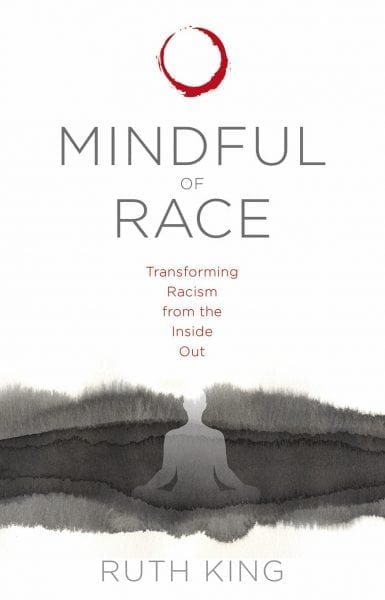Being Mindful of Race
Understanding the Cycle of Misperception
By Ruth KingThe racial ignorance and distress we see in the world today is a reflection of the mind playing itself out in grand scale on the big screen, projecting our collective conscious and unconscious conditioning.
Every one of our lives represents a mosaic, with many shades, shadows, and shapes of experiences. In our relational world of vast diversity, kinship, and division, we have all been racially conditioned, trained through many generations in how to perceive race–our own and that of others. For example, when we look at people, we often reduce them to a concept or a summation of their group identity by saying or thinking superficially: “He’s a gay guy” or “She’s an Asian woman” or “They are black or white.” So much is driven by the perceptions we have and by now these perceptions then feed certain thoughts, emotions, and beliefs. However, we were not meant to be simple summations or to be seen with casual eyes. We must be wiling to look closer to see what else is there–to see beyond the glossy print of fixed perceptions to the nuances, the subtle gradation, the treasure in the understated, even the forbidden. This discernment begins within our minds and hearts. We can become more mindful of our perceptions and use them as invitations to look more deeply at our racial habits of mind.
Buddhist teachings refer to misrepresentations as perceptual knots–ways of viewing that block freedom and keep us entangled in knotty thoughts. These misperceptions include our attachments, aversions, distortions, and delusions. They keep us thinking that life is personal and permanent and that it should be perfect. One teaching in particular, the Vipallasa Sutta, speaks to the reinforcing mechanism of misperceiving–ways we distort reality to the detriment of belonging. Simply stated, we perceive something through our senses. There is a sense organ and a sense object–eyes see, ears hear, nose smells, body feels, tongue tastes, and mind thinks. Once we perceive, the mind habitually jumps to thoughts and feelings about what is being perceived; these thoughts and feelings are rooted in past experiences, past conditioning. Thoughts and feelings then influence the mood of our mind. When perceptions, thoughts, and feelings are repeated or imprinted through experiences, they solidify into view or belief. View then reinforces perception. This cycle becomes the way in which we experience and respond to the world.
We have racially conditioned perceptions that operate based on past experiences stored in the mind. These include memories, views, beliefs, and fears, all of which stimulate the mind to act or behave in ways that make sense to us. Once we perceive race, the mind immediately scans the memory bank of past experiences to interpret what is being perceived. We then add layers of meaning and the experience shifts from bare perceiving into something more textured and nuanced. When layered, perceptions become distorted, sticky, and weighty.

Essentially, we think we know something, and then we are off and running–all based on
past experiences, preferences, and beliefs. And usually, but not always, it’s all in our minds or, at a minimum, worthy of questioning. When we perceive and when thoughts and emotions are simultaneously activated, those thoughts and emotions proliferate, creating a state of fear and anxiety driven by what the mind is believing in that moment. In such moments, we are removed from presence; we vacate the premises of body and mind and are fixated on view. And the experience is real–until it’s not. We’re streaming the past live.
We feel more reassured when our views are mirrored back to us, even if we don’t like our views. We are on guard when our views are challenged. Views that don’t align with our own go unnoticed. We stop being mindful when we think we know, and that’s when much harm can happen.
Years ago, my mom–who taught through stories and music–told me a noteworthy joke: On a one-lane zigzagging mountain road, two black guys driving down the hill pass two white police officers driving up the hill. They shout out to the cops, “Pigs, pigs!” The police officers, pissed by the perceived attack, keep driving. Seconds later, the police officer who is driving must slam on his brakes to avoid a herd of pigs crossing the road. This is the cycle of misperception at play.
Perception determines the characteristics of what it perceives–for example, whether a race is threatening or whether a race is worth paying attention to. It determines whether we like someone or something and whether we shoot someone or run. What we see in race is not inherently good or bad, right or wrong. It is our judgment about race–that is problematic. We place judgment on what we perceive; we add layers of meaning.
There is much we can do. We can make a practice of questioning our perceptions and critiquing any views and beliefs that surface in our mind that work against clear seeing, belonging, and healing. We can choose to reevaluate our racial perceptions, thoughts, emotions, and beliefs; try to recognize where they come from; and strip them of all those extra layers. Until we are willing to examine our views of racial conditioning, we’re flipping off a caution and could kill some pigs or end up dressing a mannequin in a penguin costume.
Understanding the cycle of misperception supports us in distinguishing habits of harm. How perception, thoughts, and emotions reinforce views is an important mechanism to recognize and a useful way to begin questioning our perceptions and critiquing views and beliefs that work against racial literacy, harmony, and freedom.
Mindfulness can help us recognize the cycle of misperception and use our perceptions as invitations to look deeper to unknot the inner distress and racial habits of harm so that our response to outer racial suffering can be attended to more wisely.
Ruth King is an international teacher in the insight meditation tradition. For many years, she coached executives on transformative leadership, workplace trauma, and diversity awareness. Currently she teaches the Mindful of Race training program nationwide. She is the author of Healing Rage: Women Making Inner Peace Possible.
Adapted from Being Mindful of Race: Transforming Racism from the Inside Out published by Sounds True, Copyright © 2018 by Ruth King.
Photo courtesy of Nong Vang on Unsplash.

It is a wonderful joy
today, this
encounter with
your face and
name and
voice .
Amituofo